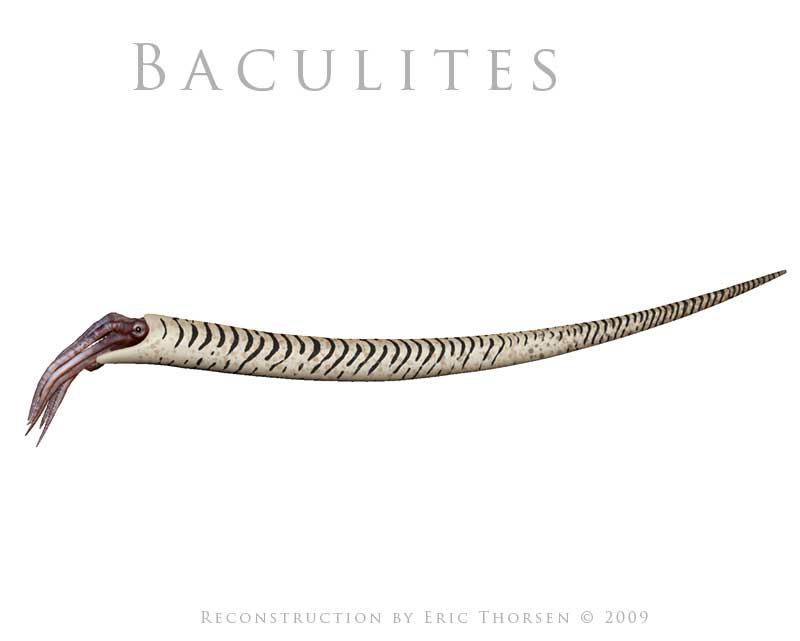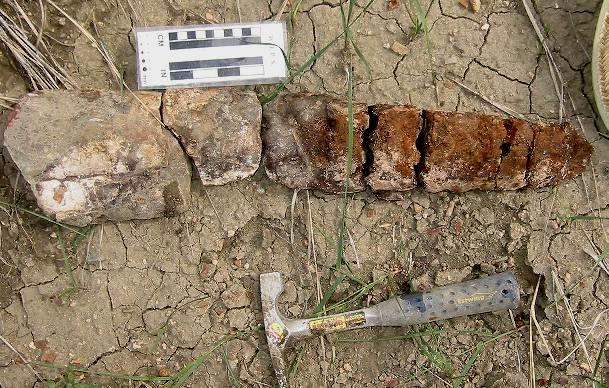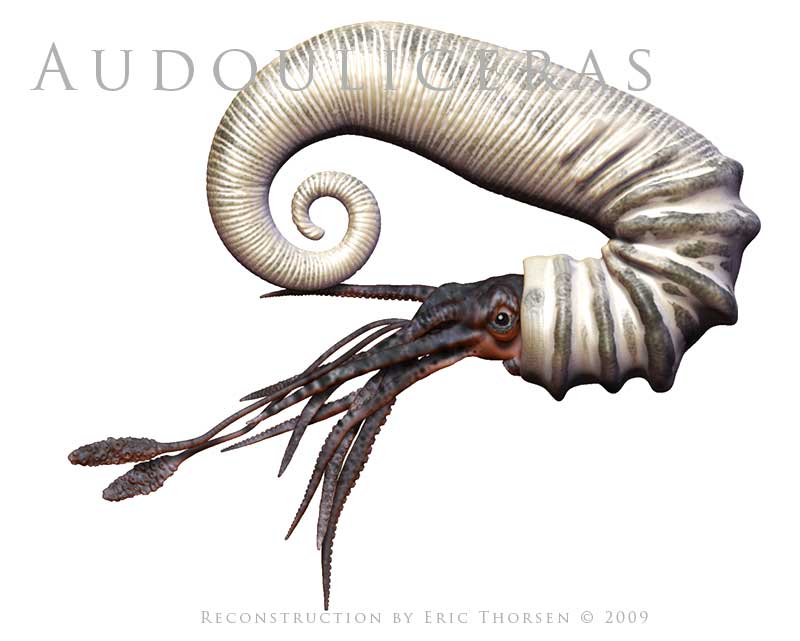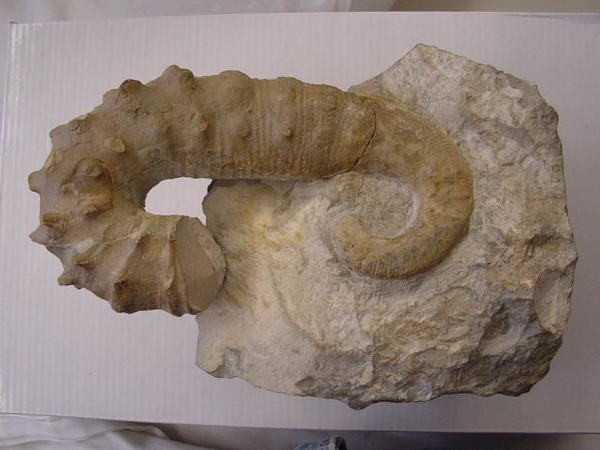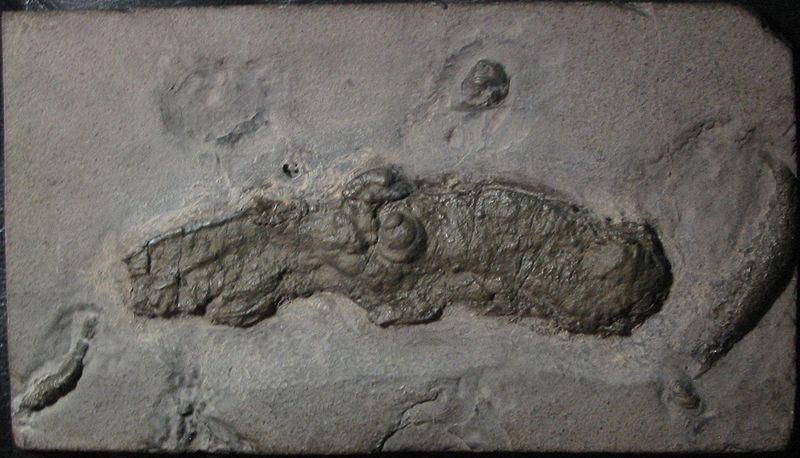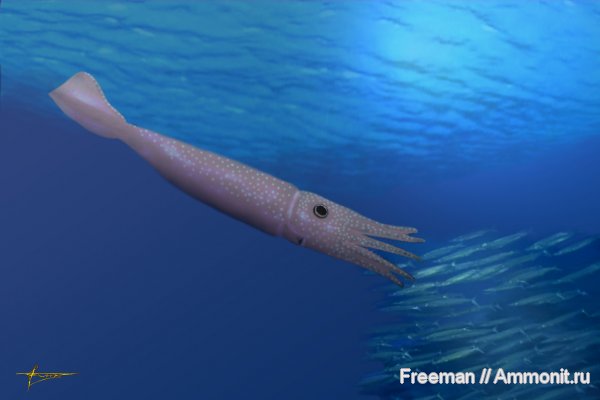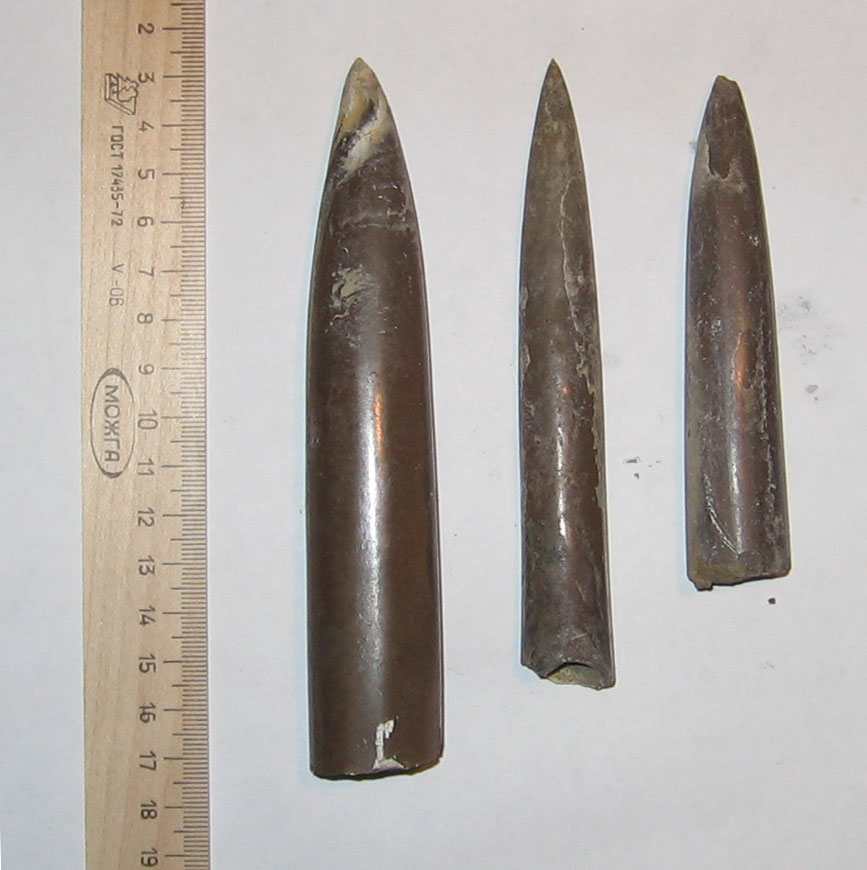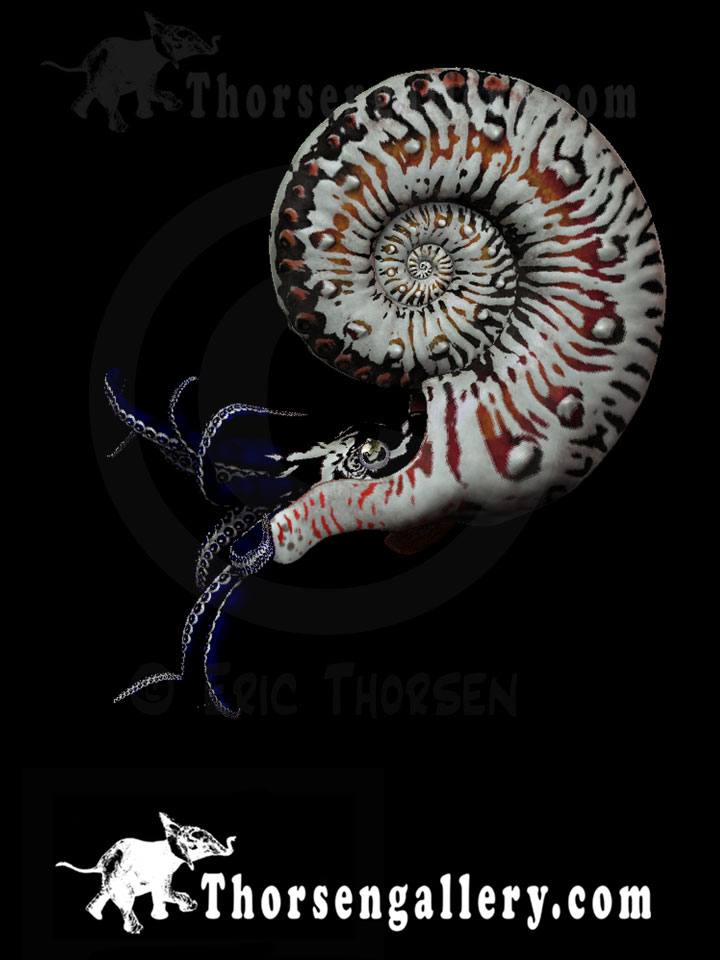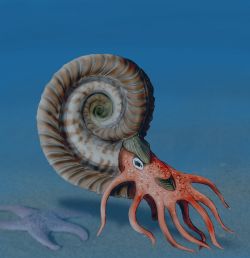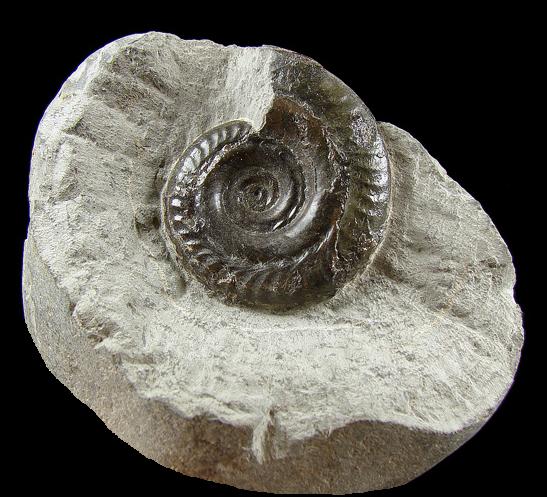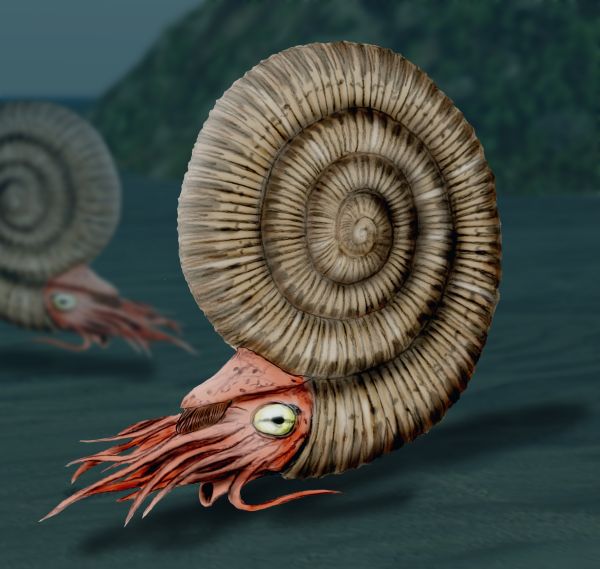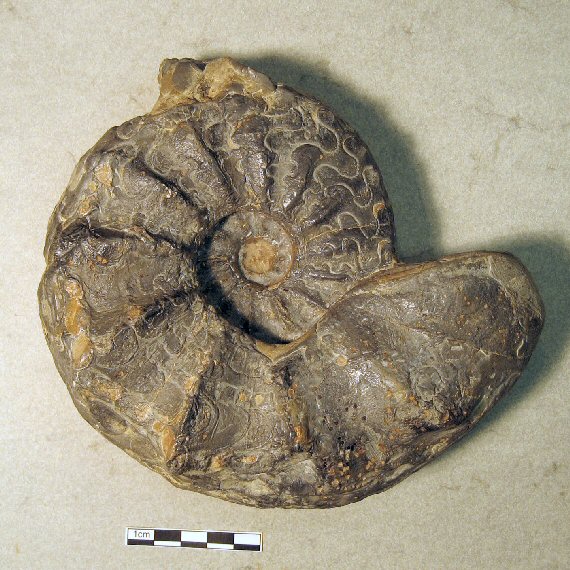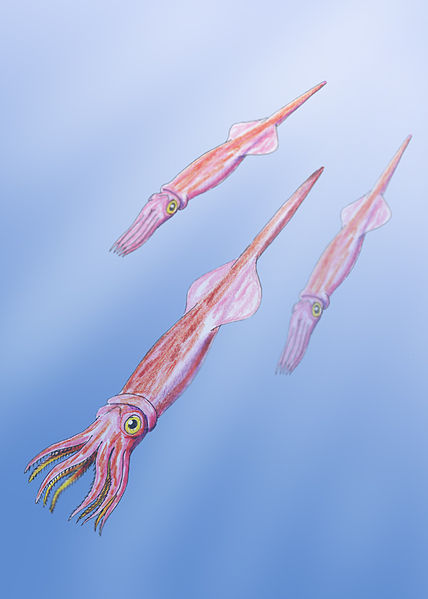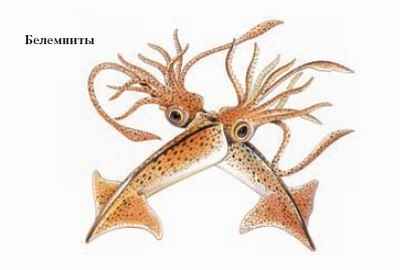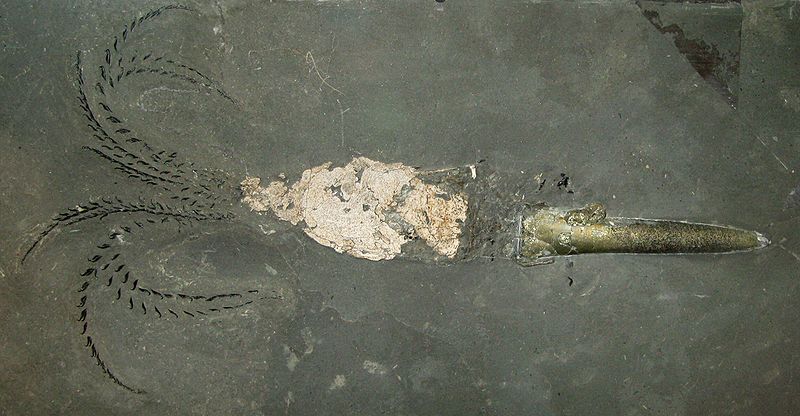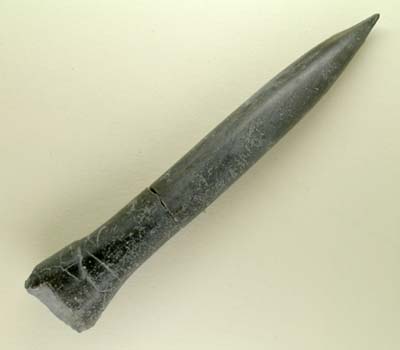[Recent Entries][Archive][Friends][User Info]
Below are 20 entries, after skipping 20 most recent ones in the "Сообщество, посвящённое ра" journal:[<< Previous 20 entries -- Next 20 entries >>]
| February 26th, 2013 | |
|---|---|
| 07:56 pm [industrialterro] [Link] |
Baculites Baculites ("walking stick rock") is an extinct cephalopod genus with a nearly straight shell that is included in the heteromorph ammonites. The genus, which lived worldwide throughout the Late Cretaceous period, was named by Jean Baptiste Lamarck in 1799. The adult shell of Baculites is generally straight and may be either smooth or with sinuous striae or ribbing that typically slant dorso-ventrally forward. The aperture likewise slopes to the front and has a sinuous margin. The venter is narrowly rounded to acute while the dorsum is more broad. The juvenile shell, found at the apex, is coiled in one or two whorls and described as minute, about a centimeter in diameter. Adult Baculites ranged in size from about seven centimeters (Baculites larsoni) up to two meters in length. As with other ammonites, the shell consisted of a series of camerae, or chambers, that were connected to the animal by a narrow tube called a siphuncle by which gas content and thereby buoyancy could be regulated in the same manner as Nautilus does today. The chambers are separated by walls called septa. The line where each septum meets the outer shell is called the suture or suture line. Like other true ammonites, Baculites have intricate suture patterns on their shells that can be used to identify different species. One notable feature about Baculites is that the males may have been a third to a half the size of the females and may have had much lighter ribbing on the surface of the shell. The shell morphology of Baculites with slanted striations or ribbing, similarly slanted aperture, and more narrowly rounded to acute keel-like venter points to its having had a horizontal orientation in life as an adult. This same type of cross section is found in much earlier nautiloids such as Bassleroceras and Clitendoceras from the Ordovician period, which can be shown to have had a horizontal orientation. In spite of this, some researchers have concluded that Baculites lived in a vertical orientation, head hanging straight down, since lacking an apical counterweight, movement was largely restricted to that direction. More recent research, notably by Gerd Westermann, has reaffirmed that at least some Baculites species in fact lived in a more or less horizontal orientation. From shell isotope studies, it is thought that Baculites inhabited the middle part of the water column, not too close to either the bottom or surface of the ocean. In some rock deposits Baculites are common, and they are thought to have lived in great shoals. However, they are not known to occur so densely as to be rock-forming, as do certain other extinct, straight-shelled cephalopods (e.g., orthocerid nautiloids). Baculites fossils are very brittle and almost always break. They are most commonly found broken in half or several pieces, usually along suture lines. Individual chambers found this way are sometimes referred to as "stone buffaloes" (due to their shapes), though the Native-American attribution typically given as part of the story behind the name is likely apocryphal. Baculites and related Cretaceous straight ammonite cephalopods are often confused with the superficially similar orthocerid nautiloid cephalopods. Both are long and tubular in form, and both are common items for sale in rock shops (often under each others' names). Both lineages evidently evolved the tubular form independently, and at different times in earth history. The orthocerid nautiloids lived much earlier (common during the Paleozoic Era and extinct by the end of the Triassic Period) than Baculites (Late Cretaceous Period only). The two types of fossils can be distinguished by many features, most obvious among which is the suture line: it is simple in orthocerid nautiloids and intricately folded in Baculites and related ammonoids. Studies on exceptionally preserved specimens have revealed a radula by synchrotron imagery. The results suggest that Baculites fed on pelagic zooplankton (as suggested by remains of a larval gastropod and a pelagic isopod inside the mouth).
Ископаемые останки (1, 2, 3, 4, 5):
Tags: Аммониты, Вымершие беспозвоночные, Мел |
| 07:49 pm [industrialterro] [Link] |
Ancyloceras Ancyloceras is an extinct genus of heteromorph ammonite cephalopod found throughout the world during the Lower Cretaceous, from the Lower Barremian epoch until the genus' extinction during the Lower Aptian.
Ископаемые останки (1, 2, 3, 4):
Tags: Аммониты, Вымершие беспозвоночные, Мел |
| 06:31 pm [industrialterro] [Link] |
Acanthohoplites Acanthohoplites is a Lower Cretaceous ammonite in the family Douvilleiceratidae that has a strongly ribbed shell and ammonitic suture. Early whorls are coronate, which later become round, then oval in section. Primary ribs may have swellings (bullae) at the umbilicus or are without. In early stages primary ribs branch mid flank at prominent lateral tubercles. In later stages lateral tubercles are reduced or absent and primary ribs branch simply at the umbilical shoulder or, again, mid flank. Sutural elements are subquadrate with narrow, shallow embayments. The first lateral lobe tends to be symmetrical. Acanthohoplites has been found in upper Aptian and lower Albian sediments in Europe, Central Asia, Japan, East Africa, Arizona, California, Oregon Mexico, and South America. Parahoplites and Hypacanthoplites are similar genera. The taxonomic position here follows the classification in the Treatise Pt L, 1957. Newer classifications may have revised taxonomies.
Ископаемые останки (1, 2, 3, 4):
Tags: Аммониты, Вымершие беспозвоночные, Мел |
| April 1st, 2012 | |
| 04:54 pm [industrialterro] [Link] |
Trachyteuthis Trachyteuthis is a genus of fossil teuthid, comprising four species: T. hastiformis, T. nusplingensis, T. teudopsiformis, and T. covacevichi. The taxonomic placement of Trachyteuthis is uncertain. Though often assigned to the order Vampyromorphida, the discovery of fossilised Trachyteuthis beaks in the Upper Jurassic limestone of Germany suggests a close phylogenetic relation to the Octopoda. It is clear that it does at least belong in the Coleoidea. It is thought to be very closely related to Teudopsis. Fossils are scarce but have been reported from the Kimmeridge clay of the UK; the Solenhofen limestone of Germany, Jurassic deposits in Antarctica, and Oxfordian deposits in Chile. First described in 1773 as the remnants of a fish, Trachyteuthis was considered comparable to a Sepia cuttlebone by Rüppell in 1829. A separate genus was erected for the material in 1846 by Meyer. English material was discovered in 1855 and termed Coccoteuthis latipinnis; this was later synonymised with the identical Solnhofen deposits. A 2007 survey of museum collection established that there were ground for the erection of three species within the genus.
Tags: Вымершие беспозвоночные, Юра |
| 04:38 pm [industrialterro] [Link] |
Vampyronassa Vampyronassa rhodanica is an extinct vampyromorph cephalopod known from around 20 fossils from the Lower Callovian (165–164 Ma) of La Voulte-sur-Rhône, Ardèche, France. It differs from the modern Vampire Squid in having longer first dorsal arms, a larger hyponome, and a more elongated mantle.
Tags: Вымершие беспозвоночные, Юра |
| 04:19 pm [industrialterro] [Link] |
Cylindroteuthis Cylindroteuthis is a genus of belemnite that lived from the Early Jurassic to the Early Cretaceous. Its fossils have been found in Asia, Europe, North America, and New Zealand. Cylindroteuthis was first described in 1879 by Claude-Emile Bayle. A belemnite originally described as the Cylindroteuthis species C. confessa has been re-described as Mesoteuthis soloniensis. Cylindroteuthis is a common find from several Jurassic formations. Specimen length ranges from 4 inches (10 cm) to 8.5 inches (22 cm). The most commonly preserved part of the animal is its guard, or rostrum, which was composed of calcite. The guard would not have been found on the exterior of Cylindroteuthis, as traces of blood vessels have been discovered on some guards, suggesting that it was an internal feature. The guard housed a phragmocone, which allowed Cylindroteuthis to maintain buoyancy in water. Some better-preserved specimens have features similar to modern squid, such as ten arm-like appendages and an ink sac, intact. Cylindroteuthis has been recovered from the Temaikan Boatlanding Bay formation of Australasia. Three species of Cylindroteuthis (C. knoxvillensis, C. cf. newvillensis, and C. venusta) have been described from the Arctic region. In addition, about 2350 belemnite guards (including those of Cylindroteuthis) have been recovered from Lower Cretaceous formations of northeastern Greenland, suggesting the presence of a sort of "immigration route" for belemnites. The findings also suggest the existence of a "proto Gulf-stream" as early as the Valanginian.
Tags: Вымершие беспозвоночные, Юра |
| March 31st, 2012 | |
| 06:36 pm [industrialterro] [Link] |
Peltoceras Peltoceras is an extinct ammonite genus from the aspidoceratid subfamily Peltoceratinae that lived during the later part of the Middle Jurassic (U Callovian). The shell of Peltoceras is evolute with whorls hardly embracing, so that all whorls are mostly exposed. The outer rim, which is known as the venter, aligning with the lower part or belly of the animal, is nearly flat. Inner whorls have strong ribs that bifurcate and trifurcate on the ventral margin. The outer whorls have large simple ribs and two rows of massive lateral tubercles, the outer row developing first.
Ископаемые останки (1, 2, 3, 4):
Tags: Аммониты, Вымершие беспозвоночные, Юра |
| 06:18 pm [industrialterro] [Link] |
Kosmoceras Kosmoceras — род вымерших головоногих моллюсков семейства Kosmoceratidae, подкласса аммоноидеи. Были распространены, главным образом, в Суббореальной области Панбореальной биогеографической надобласти в среднем-позднем келловее (средняя юра). На аммонитах рода Kosmoceras основано зональное расчленение среднего и верхнего подъярусов келловейского яруса. В большинстве разрезов Европы представители рода Kosmoceras исчезают незадолго до конца келловея. Самые поздние Kosmoceras известны из биогоризонта paucicostatum (зона lamberti верхнего келловея) Северного Кавказа. Раковины рода Kosmoceras были покрыты шипами, отличающимися у различных видов по форме — от небольших округлых выступов до тонких иглообразных. Однако данные шипы плохо и очень редко сохраняются в ископаемом состоянии.
Tags: Аммониты, Вымершие беспозвоночные, Юра |
| 06:01 pm [industrialterro] [Link] |
Hildoceras Hildoceras is a genus of ammonite form the upper Lower Jurassic in the family Hildoceratidae. The shells are characterized by a narrow discoidal evolute shape, keeled venter, concave ribs along the outer flanks, and a shallow spiral goove running along smooth inner flanks. Whorls slightly overlap, cross sections are compressed. The ventral keel is bordered on either side by a shallow groove. The genus was named by Alpheus Hyatt after Saint Hilda in 1876, and fossils have been found in Europe and Japan. Род Hildoceras, объединяющий одних из наиболее типичных аммонитов юрского периода, был назван в честь святой Хильды. Самый распространенный вид рода Hildoceras bifrons является руководящим ископаемым: он существовал на протяжении короткого, по геологическим меркам, периода времени и потому дает возможность довольно точно датировать слои горных пород. Его широкая географическая распространенность позволяет проводить детальное сравнение содержащих его слоев и точно указывает на их одинаковый возраст. Эти аммониты отличаются эволютной плоскоспиральной раковиной: каждый новый оборот располагается поверх предыдущего. Сечение оборотов имеет характерную квадратную форму. Интересной особенностью Hildoceras являются простые, серпообразно изгибающиеся, ребра, развитые на боковых сторонах раковины. На боковой поверхности проходит продольная ложбинка, по обе стороны от которой ребра имеют различную ориентацию. Род аммонитов Hildoceras получил наиболее широкое географическое распространение в юрском периоде. Множество окаменелостей этого рода было найдено в Европе, Северной Африке, на Кавказе, в Турции, Иране и Японии. Аммониты, вместе с современными кальмарами и осьминогами, относятся к цефалоподам, или головоногим моллюскам. Основным отличием аммонитов служит их внешний скелет в форме спиральной раковины, тогда как кальмары ограничиваются минимальным внутренним скелетом, а у осьминогов его и вовсе нет. Кальмары и осьминоги также живут в морях и океанах, они весьма умны и охотятся на других водных животных. Вполне вероятно, что их поведение во многом сходно с поведением аммонитов.
Tags: Аммониты, Вымершие беспозвоночные, Юра |
| 05:41 pm [industrialterro] [Link] |
Dactylioceras Dactylioceras was a widespread genus of ammonite from the Jurassic period, approximately 172 million years ago (mya). They are generally small, averaging 65 mm in diameter. Dactylioceras has a strong, ribbed shell. The ribs are slightly inclined forward, running over the outer edge, and either simple or forking at outer end. Though it eventually died out 180 mya, their style of ribbing was copied by numerous subsequent ammonite genera until the whole group became extinct 65 million years ago with the dinosaurs. Dactylioceras probably lived by scavenging on the sea floor. Mass mortality specimens of Dactylioceras are common, and perhaps suggest that these ammonites may often have died shortly after spawning. The dead shells were probably gently washed up into a shell bank on the margins of the Lower Jurassic seas. Flow tank experiments show that Dactylioceras was probably a slow swimmer. Dactylioceras has been collected from almost every continent, and was one of the most successful ammonite lineages ever. They are abundant throughout Europe, with exceptionally fine specimens found in England and Germany. Like many other ammonites, the genus Dactylioceras is extremely important in biostratigraphy, being a key index fossil for identifying their region of the Jurassic. The name Dactylioceras comes from the Greek dactyl, meaning “finger”, and refers to the shell’s branching ribs.
Tags: Аммониты, Вымершие беспозвоночные, Юра |
| 05:32 pm [industrialterro] [Link] |
Asteroceras Asteroceras is an extinct genus of cephalopod belonging to the Ammonite subclass. Asteroceras fossils may be found at Lyme Regis in the Asteroceras obtusum zone of Upper Sinemurian age. Asteroceras is a genus of Ammonites natvie to England durring the Jurassic Era. The genus of Asteroceras included five species, including Asteroceras confusum. Asteroceras fossils were most commonly found in the Lyme Regis, located in Dorset, England.
Tags: Аммониты, Вымершие беспозвоночные, Юра |
| 05:18 pm [industrialterro] [Link] |
Aspidoceras Aspidoceras is an extinct ammonoid cephalopod genus that lived during the Late Jurassic (Kimmeridgian) with a fairly broad distribution. Aspidoceras, named by Zittel, 1868, is the type genus for the persphictacian family Aspidoceratidae and subfamily Aspidoceratinae in which it is included. Aspidoceras has an evolute shell with quadrate-rounded or depressed whorls that have two rows of tubercles, the outer near the middle of the whorl sides. The outer row soon fades in many species. Some species are also ribbed. The venter, or outer rim, is generally wide and broadly arched. Aspidoceras is predated by Euaspidoceras, possibly its ancestor, and is considered related to genera like Orthaspidoceras, Simaspidoceras, and Intranodites.
Ископаемые останки (1, 2, 3, 4):
Tags: Аммониты, Вымершие беспозвоночные, Юра |
| 04:53 pm [industrialterro] [Link] |
Arietites Arietites is a genus of massive, giant evolute, psiloceratacean ammonites in the family Arietitidae in which whorls are subquadrate and transversely ribbed and low keels in tripicate, separated by a pair of longitudinal grooves, run along the venter. Fossils are known world wide from the lower Sinemurian stage of the Lower Jurassic. Similar genera include Megarietites in which the keels are reduced and Epammonites in which the ribs are more closely spaced.
Tags: Аммониты, Вымершие беспозвоночные, Юра |
| December 13th, 2011 | |
| 07:59 pm [industrialterro] [Link] |
Ceratites Ceratites ("Horn Stone") is an extinct genus of ammonite cephalopod that lived in marine habitats in what is now Europe, Asia, and North America during the Triassic. It has a ceratitic suture pattern on its shell.
Tags: Аммониты, Вымершие беспозвоночные, Триас |
| 07:55 pm [industrialterro] [Link] |
Balatonites Balatonites is an extinct cephalopod genus belonging to the ceratitid family Balatonitidae. There are at least four known species: B. balatonicus, B. oyama, B. shoshonensis, and B. zitteli. The shell of Balatonites is essentially evolute, coiled with earlier whorls showing, and is laterally compressed with flattish sides and a roof-like venter. The sides are covered with radial ribs that have tubercles generally arranged in umbilical, median and ventral rows. Balatonites has been found in the Alps, Balkans, Germany, Japan, and Nevada.
Tags: Аммониты, Вымершие беспозвоночные, Триас |
| 07:42 pm [industrialterro] [Link] |
Arcestes Arcestes is an extinct ammonite cephalopod genus belonging to the Ceratitida. Their shells were broad and rounded, giving them an almost spherical appearance. Unlike many other ammonites, the shells of Arcestes lack keels that would otherwise stabilize them while swimming. Because of this, some paleontologists have suggested that they were bottom-dwelling crawlers. The shell of Arcestes is globular or subglobular with periodic narrow transverse constrictions in internal molds due to periodic internal transverse ridges (variaces) in the shell. The suture is ammonitic with complexly subdivided elements. The ventral lobe is subdivided by a low median saddle. Lateral lobes and saddles have generally triangular outlines but are deeply embayed by strong projections forming tree-like patterns. They form a series diminishing in size and complexity in a rather straight line going from the venter to the umbilicus in the middle of the shell. Fossils of Arcestes are found in Mid to Upper Triassic marine strata throughout the world, including California (A. pacificus), Nevada (A (Anisarcestes) mrazici) and Austria (A. intuslabiatus and A. binacostomus).
Tags: Аммониты, Вымершие беспозвоночные, Триас |
| October 23rd, 2011 | |
| 12:27 pm [industrialterro] [Link] |
Cooperoceras Cooperoceras is a genus of the Tainoceratidae, which is part of the Tainocerataceae, characterized by and evolute shell with an open, perforate, umbilicus, sinuous ribs at maturity, and recurved hollow spines along the ventro-lateral shoulders. The flanks and venter are flattened, the flanks converge on the dorsum, the venter has a shallow median groove. The suture is with rounded ventral and lateral lobes. The siphuncle is small, tubular, and subcentral. (Kummel 1964, K413) Cooperoceras, known from the Lower Permian of N America and Europe (Urals), was named by Miller in 1945. The genotype is Cooperoceras texanum. The phylogenetic relationships of Cooperoceras are unclear.
Tags: Аммониты, Вымершие беспозвоночные, Пермь |
| October 21st, 2011 | |
| 08:01 pm [industrialterro] [Link] |
Xenodiscus Xenodiscus is an extinct ammonoid cephalopod genus and one of the earliest ceratites, found in the Upper Permian of northern India and Timor. Xenodiscus is included in the family Xenodiscidae which is part of the ceratite superfamily Xenodiscaceae Xenodiscus has a thinly discoidal and ribbed shell with ceratitic sutures, coiled so all whorls are exposed. The whorl section is subquadrate and compressed, so as to be narrower than high.
Tags: Аммониты, Вымершие беспозвоночные, Пермь |
| 07:54 pm [industrialterro] [Link] |
Uraloceras Uraloceras is an ammonoid cephalopod genus belonging to the goniatitid family Paragastrioceratidae. The genus was named by Ruzhencev 1936 and is a jr. synonym of Pseudogastrioceras Spath 1930 according to Miller, Furnish and Schindeworlf, 1957. More recent classifications however list the two as distinct genera and put Uraloceras in the Paragastrioceratinae and Pseudogastrioceras in the Pseudogastrioceratinae. Uraloceras, which comes from the Permian, is involute with a small to medium umbilicus and rounded venter. The shell is covered by longitudinal ribbing or coarse lirae. The suture, as characteristic of the family, has eight lobes, of which only the ventral one is bifurcate.
Tags: Аммониты, Вымершие беспозвоночные, Пермь |
| October 1st, 2011 | |
| 06:01 pm [industrialterro] [Link] |
Belemnitida Белемниты (Belemnitida) — представители отряда вымерших беспозвоночных животных класса головоногих моллюсков. Белемниты существовали с каменноугольного по палеогеновый период. Внешне похожи на кальмаров, но, в отличие от них, имели внутреннюю раковину, состоящую из трёх частей — ростра, фрагмокона и проостракума. Лучше всего в ископаемом состоянии сохраняется ростр белемнита — прочное коническое образование на заднем конце тела. В длину обычно достигали 15—20 см (из среднеюрских отложений Европы известен род Megatheutis, длина ростра которого достигала 50 сантиметров, а общая длина тела белемнита могла доходить до 3 метров). Белемниты обитали в морях, вели хищный образ жизни, большинство белемнитов хорошо плавало. В связи с широким распространением, обилием родов (около 50) и видов, а также их быстрой сменой во времени белемниты служат руководящими ископаемыми для юрских и меловых отложений. Народное название белемнитов — «чёртов палец», «громовая стрела», «стрелы Перуна». В народной медицине используется порошок из белемнита. Считается, что он обладает антисептическими свойствами.
Ископаемые останки (1, 2, 3, 4):
Tags: Вымершие беспозвоночные, Карбон |
